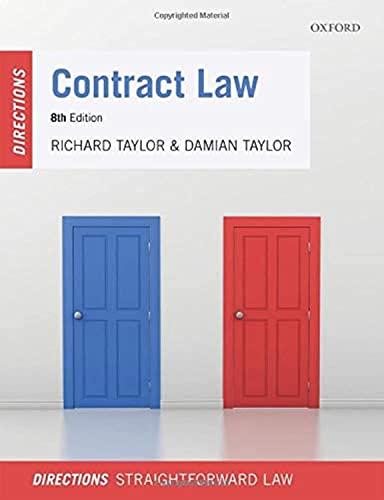Question
hi can you typ e A conclusion that summarises the material presented below It was decided in 1897 in the landmark English contract law case
hi can you typ e A conclusion that summarises the material presented below
It was decided in 1897 in the landmark English contract law case of Salomon v. Salomon & Co. Ltd. that a company is a separate legal entity from its shareholders. This case is considered to be one of the most important in English contract law.
This case was brought about as a result of Salomon's shoe business going bankrupt. In exchange for shares, Salomon had transferred the company's ownership to a new entity that would be entirely owned by him and his family. When Salomon's company went bankrupt, his creditors went after him personally in an attempt to collect the money they were owed by him.
The judge ruled that Salomon could not be held liable for the debts of the company because he had transferred the business to a company that was a separate legal entity from himself. This meant that Salomon could not be held responsible for the debts of the company. Since then, this principle has been made legally binding through the Companies Act of 2006.
The "limited liability company," which has since become the most common form of business organization around the world, owes its existence to this case, making it an important milestone in the history of business law.
The following topics will be presented:
The pertinent details of the situation
- The verdict handed down by the court
- The importance of this case in general
- The effect of the case on laws governing companies
The case of Salomon v. Salomon & Co Ltd. was heard and decided by the English Court of Appeal in the year 1897. This landmark English contract law case established that a company is a separate legal entity from its shareholders and is considered a leading precedent in the field.
This case was brought about as a result of Salomon's shoe business going bankrupt. In exchange for shares, Salomon had transferred the company's ownership to a new entity that would be entirely owned by him and his family. When Salomon's company went bankrupt, his creditors went after him personally in an attempt to collect the money they were owed by him.
The judge ruled that Salomon could not be held liable for the debts of the company because he had transferred the business to a company that was a separate legal entity from himself. This meant that Salomon could not be held responsible for the debts of the company. Since then, this principle has been made legally binding through the Companies Act of 2006.
In the case of Salomon v Salomon & Co Ltd, the judges ruled that Mr Salomon was entitled to treat the company as a separate legal entity to himself, even though he was the sole shareholder and director. They said that the company was a 'separate person' in law and that Mr Salomon could not be held liable for its debts. This was because the company had been incorporated according to the law and so was a distinct legal entity.
The case was brought about because Mr Salomon had transferred his business to a company that he had incorporated, of which he was the sole shareholder and director. The company then went into liquidation and the creditors claimed that Mr Salomon should be held liable for the debts of the company.The judges ruled in favour of Mr Salomon, saying that he was entitled to treat the company as a separate legal entity. They said that the company was a 'separate person' in law and that Mr Salomon could not be held liable for its debts. This was because the company had been incorporated according to the law and so was a distinct legal entity.
This case established the principle of limited liability, which is a key feature of modern companies. It means that shareholders are only liable for the amount of money they have invested in the company and cannot be held liable for the debts of the company. This principle provides a degree of certainty and stability for investors, which is vital for the functioning of the modern economy.
Step by Step Solution
There are 3 Steps involved in it
Step: 1

Get Instant Access to Expert-Tailored Solutions
See step-by-step solutions with expert insights and AI powered tools for academic success
Step: 2

Step: 3

Ace Your Homework with AI
Get the answers you need in no time with our AI-driven, step-by-step assistance
Get Started


